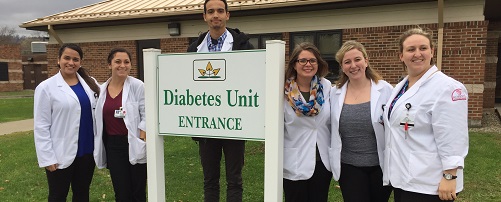Read the latest news on Roberts, our alumni, and the campus community. Check here for alumni updates as well. Click here to send us your updates!
Nursing Students Work with the Seneca Nation of Indians
Nursing faculty Sam Brzoza and Sharon Davis embraced a new cultural opportunity for nursing students in the NSG 404 course. After intense planning with the Nursing leaders at Seneca Nation Health Center in Salamanca, NY, the clinical site of Seneca Health Center was offered for twenty students during the fall semester of NSG 404, Community Health.
The Seneca Nation of Indians, known as the “Keeper of the Western Door”, has a proud history and continues to be the largest of six Native American nations. Nursing students arrive on the Seneca Nation campus and receive an orientation that exposes students to the rich history of the Seneca as well as their current customs, health beliefs, language, and faith practices.
The Seneca Nation Health System provides comprehensive health services to Allegany, Cattaraugus, Chautauqua, Erie and Niagara counties in New York and Warren County in Pennsylvania. The Center provides services in family health care, prenatal care, health maintenance and prevention screenings, well baby and child care along with laboratory, pharmacy, nutrition and dietary counseling, family planning, health education, exercise, mental health, and substance abuse counseling. Services are provided by a multi-disciplinary team of health professionals.
Sam and Sharon have stated: “This is a tremendous opportunity for our students to examine cultural practices first hand. The Seneca Health Center offers such a rich experience for our students.” Students work with RNs that are managing patients in several specialty clinics, through telephone triage and during community health visits.
Sam and Sharon realized the impact on the students when a student wrote the following in a reflective journal:
“The role of the nurse in these communities is to provide patient-centered care that meets the specific cultural needs of the patients.” Another student added: “I think learning the history first helped to have a better understanding of the client population.”
